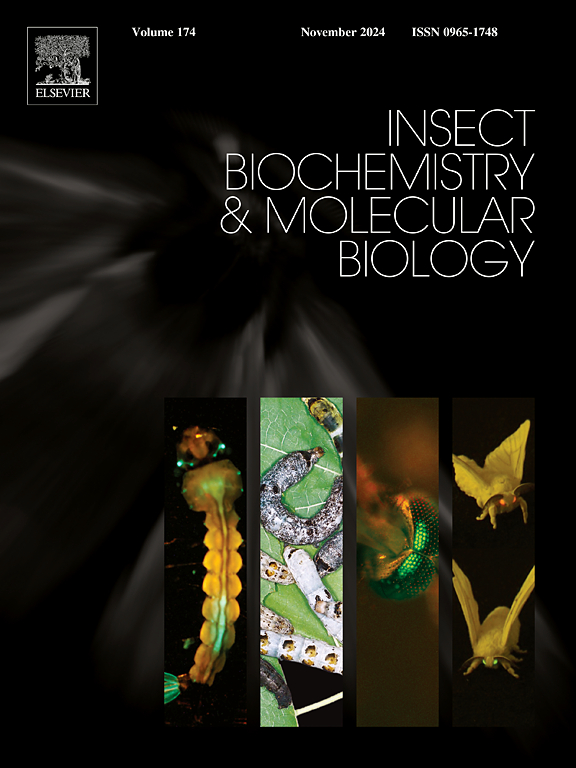A unique mechanism of transfluthrin action revealed by mapping its binding sites in the mosquito sodium channel
IF 3.2
2区 农林科学
Q2 BIOCHEMISTRY & MOLECULAR BIOLOGY
引用次数: 0
Abstract
Pyrethroid insecticides exert their toxic action by prolonging the opening of insect voltage-gated sodium channels, resulting in the characteristic tail current during membrane repolarization in voltage clamp experiments. Permethrin (PMT) and deltamethrin (DMT), representative type I and type II pyrethroids, respectively, are predicted to bind to two lipid-exposed pyrethroid receptor sites, PyR1 and PyR2, at the lipid-exposed interfaces of repeats II/III and I/II, respectively. Transfluthrin (TF), a volatile type I pyrethroid and mosquito repellent, has received increased attention in the global combat of vector-borne human diseases. However, the electrophysiological and molecular bases of TF action on insect sodium channels remain unexplored. In this study we discovered that, unlike DMT and PMT, TF barely induces the characteristic tail current of the Aedes aegypti mosquito sodium channel (AaNav1-1) expressed in Xenopus oocytes. Instead, TF induces a unique persistent current. We docked TF into the AlphaFold2 model of AaNav1-1 and found that the tetrafluorophenyl ring of TF binds to alpha helices S5, P1, and S6, but not to the linker helices S4-S5 within either PyR1 or PyR2. In agreement with the model, functional examination of 15 AaNav1-1 mutants demonstrated that substitutions of DMT/PMT-sensing residues in helices S5, P1, and S6, but not in the linker-helices S4-S5, altered channel sensitivity to TF. These results revealed the unique action of TF on channel gating and suggest a distinct subtype of type I pyrethroids with a previously uncharacterized pattern of interactions with residues at the dual pyrethroid receptor sites.

通过绘制蚊子钠通道中的结合位点揭示高效氯氟氰菊酯的独特作用机制
拟除虫菊酯类杀虫剂通过延长昆虫电压门控钠通道的开放时间来发挥其毒性作用,从而在电压钳夹实验中产生膜再极化过程中的特征性尾流。氯菊酯(PMT)和溴氰菊酯(DMT)分别是具有代表性的 I 型和 II 型拟除虫菊酯,据推测它们会分别与位于重复序列 II/III 和 I/II 的脂质暴露界面上的两个脂质暴露的拟除虫菊酯受体位点 PyR1 和 PyR2 结合。高效氟氯氰菊酯(TF)是一种挥发性 I 型拟除虫菊酯和驱蚊剂,在全球防治病媒传播的人类疾病方面受到越来越多的关注。然而,TF 作用于昆虫钠通道的电生理学和分子基础仍有待探索。在这项研究中,我们发现,与 DMT 和 PMT 不同,TF 几乎不能诱导在爪蟾卵母细胞中表达的埃及伊蚊钠通道(AaNav1-1)的特征性尾流。相反,TF 能诱导一种独特的持续电流。我们将 TF 与 AaNav1-1 的 AlphaFold2 模型对接,发现 TF 的四氟苯基环能与 S5、P1 和 S6 α 螺旋结合,但不能与 PyR1 或 PyR2 中的 S4-S5 连接螺旋结合。与该模型一致,对 15 个 AaNav1-1 突变体进行的功能检查表明,在 S5、P1 和 S6 螺旋中的 DMT/PMT 感应残基的取代,而不是在连接螺旋 S4-S5 中的取代,会改变通道对 TF 的敏感性。这些结果揭示了 TF 对通道门控的独特作用,并表明 I 型拟除虫菊酯有一种独特的亚型,其与双拟除虫菊酯受体位点残基的相互作用模式以前从未描述过。
本文章由计算机程序翻译,如有差异,请以英文原文为准。
求助全文
约1分钟内获得全文
求助全文
来源期刊
CiteScore
7.40
自引率
5.30%
发文量
105
审稿时长
40 days
期刊介绍:
This international journal publishes original contributions and mini-reviews in the fields of insect biochemistry and insect molecular biology. Main areas of interest are neurochemistry, hormone and pheromone biochemistry, enzymes and metabolism, hormone action and gene regulation, gene characterization and structure, pharmacology, immunology and cell and tissue culture. Papers on the biochemistry and molecular biology of other groups of arthropods are published if of general interest to the readership. Technique papers will be considered for publication if they significantly advance the field of insect biochemistry and molecular biology in the opinion of the Editors and Editorial Board.

 求助内容:
求助内容: 应助结果提醒方式:
应助结果提醒方式:


